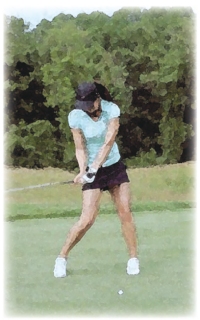Current Trends in Coaching Teaching Golf w Golf Teaching
 It goes without saying that golf teaching is constantly evolving. From the fi rst teachers who simply demonstrated to their students what to do, to today’s instructors who have high-tech computers, training aids, and launch monitors, teaching has certainly progressed exponentially from its humble beginnings.
It goes without saying that golf teaching is constantly evolving. From the fi rst teachers who simply demonstrated to their students what to do, to today’s instructors who have high-tech computers, training aids, and launch monitors, teaching has certainly progressed exponentially from its humble beginnings.
One trend that has become more prevalent at the tour levels is for players to have different coaches for different aspects of their game. A player might have separate coaches for his or her full swing, short game, and putting
(think Phil Mickelson). They might also employ a nutrition coach, an exercise coach, and a mental coach. With the competition so fi erce and closely contested, any edge a player can gain from employing so many coaches is sure to be strongly considered.
One danger in having so many coaches, though, is that a player may not become as self-suffi cient as they need to be in order to play the game at a high level. Competitive golf, by its very nature, requires a certain amount of independence and self-reliance. Do you remember Ty Tryon? He successfully went through the PGA Tour qualifying school at the age of 17. He had almost a dozen handlers and coaches involved in his career. Today
Tryon is still trying to eke out a living on various mini-tours around the country, but his is a sad story of unfulfilled great potential. It’s possible – and maybe even likely – in his case that he never really learned to deal with the ups and downs of being a professional golfer, because so many people were there to give him counsel on every aspect of his game and career, instead of allowing him to figure out and learn things on his own.
Michelle Wie is another example of young promise unfulfilled… as of this writing. She may still find her game and go on to be a great champion. Her story is a little more complicated, as she matriculated at Stanford University as a full-time college student. Some saw this as a lack of desire, but no one says that about other promising junior golfers who go to college. No, the downturn in her game coincided with the increased coaching she received in her game. Here was a teenage girl who played so well in so many women’s major championships, but instead of finding her own way, she became over-coached.
Over-coaching is a problem that is very real, and there are more examples than Tryon and Wie that can be used as evidence. Thankfully, the pendulum seems to be swinging back, as one of the trends in golf coaching today is toward “less is better.” USGTF professional Won Seop Yoon, who coaches a number of tour players in Japan and Korea, says he stays away from too many technical aspects and simply works on setup and balance.
As far as swing technique goes, there is a strong trend of getting rid of excess movement in the swing. One manifestation of this is in the restricted backswing hip turns of today’s players. Another is in the quieter transitions from backswing to downswing. Can you visualize Ben Hogan’s swing? He had a very pronounced lower body movement towards his left side, well before his upper body completed its backswing. In contrast, through highspeed cameras, we see that many tour players today come to almost a complete stop on their backswings before starting down with their lower bodies.
Another trend in coaching is the use of alignment sticks. Most tour players carry them in their bags, and even on driving ranges throughout the country, many average players can be seen with them.
When it comes to putting, most coaches today prefer an arcing stroke instead of straight-back and straight-through. The predominant reasoning for this is that the putter shaft is on an incline and not meant to go straight back and straight through. Yet, many players continue to find success with the straightback and straight-through method.
Junior golfers today are advised to “hit it far today and hit it straight tomorrow,” although this is not exactly an innovation. Jack Nicklaus and Arnold Palmer were advised as juniors to do the same thing. But, for some reason, teachers did not take a page from Jack Grout (Nicklaus’ teacher) and Deacon Palmer (Palmer’s teacher and father), and for many years technique was stressed over developing distance. However, teachers and coaches today see that successful players hit the ball a certain minimum distance, and short hitters can no longer compete, no matter how well they may strike the ball and chip and putt.
Finally, another part of the coaching trend is the formation of the USGTF coaching division, the World Golf Coaches Alliance. Coaches of competitive golfers now have educational resources that will help them optimally prepare their players. With competitive golf being so closely contested, coaches everywhere are looking for that edge which will put their players over the top. Instructional DVDs on every aspect of coaching golf are now available through the WGCA, and gives these coaches the information that they need.
It will be interesting to see what teaching trends develop in the future, but one thing’s for certain – things will, indeed, change.




